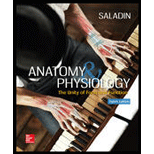
Introduction:
Structures that are specialized for the detection of a stimulus, such as pain and heat, are referred to as a sensory receptor. Such receptors can either be real sense organs or simple nerve endings. Sense organs are involved in the transmission of data (through neurons) to the specific place inside the nervous system. Such sense organs may range from simple microscopic structures, like dendrites, to complex structures, like ear and eye. Receptors can be classified into three categories based on the stimulus origin, modality, and its location in the body. The classification of taste receptors: (i) based on the modality of the stimulus: chemoreceptors; (ii) based on the stimulus origin: exteroceptors; and (iii) based on the location of receptors in the body: specific senses.
Want to see the full answer?
Check out a sample textbook solution
Chapter 16 Solutions
Anatomy & Physiology: The Unity of Form and Function
- The inner layer of the eye includes the _____________. a. lens and choroid b. sclera and cornea c. retina d. start of optic nervearrow_forwardThe outer layer of the eye includes the____________. a. lens and choroid b. sclera and cornea c. retina d. both a and carrow_forwardYour visual field is ______________. a. a specific, small area of the retina b. what you actually see c. the area where color vision occurs d. where the optic nerve startsarrow_forward
- Which of the following has the fewest taste receptors? fungiform papillae circumvallate papillae foliate papillae filiform papillaearrow_forward___ is defined as a decrease in the response to an ongoing stimulus. a. Perception b. Visual accommodation c. Sensory adaptiltion d. Somatic sensationarrow_forwardLabel the parts of the eye:arrow_forward
- Watch this video (http://openstaxcollege.org/l/DanielleReed) to learn about Dr. Danielle Reed of the Monell Chemical Senses Center in Philadelphia, PA, who became interested in science at an early age because of her sensory experiences. She recognized that her sense of taste was unique compared with other people she knew. Now, she studies the genetic differences between people and their sensitivities to taste stimuli. In the video, there is a brief image of a person sticking out their tongue, which has been covered with a colored dye. This is how Dr. Reed is able to visualize and count papillae on the surface of the tongue. People fall into two large groups known as tasters and non-tasters on the basis of the density of papillae on their tongue, which also indicates the number of taste buds. Non-tasters can taste food, but they are not as sensitive to certain tastes, such as bitterness. Dr. Reed discovered that she is a non-taster, which explains why she perceived bitterness differently than other people she knew. Are you very sensitive to tastes? Can you see any similarities among the members of your family?arrow_forwardConnoisseurs can recognize many varieties of cheese or wine by “tasting.” How can they do so when there are only a few types of taste receptors?arrow_forwardThere are only five distinct basic tastes, but thousands of different odors. Demonstrate your understanding of the olfactory system by making a reasonable hypothesis that explains how a vast number of chemical odorants can be recognized?arrow_forward
- From a biological perspective, how do we experience taste? Discuss the composite of the five basic taste sensations. Include a relevant example. Please include references.arrow_forwardof the known 5 senses of taste which generates gustatory signals from the largest diversity molecular geometrics and compositionsarrow_forwardTrace a sensory impulse from a taste receptor to thecerebral cortex.arrow_forward
 Human Biology (MindTap Course List)BiologyISBN:9781305112100Author:Cecie Starr, Beverly McMillanPublisher:Cengage Learning
Human Biology (MindTap Course List)BiologyISBN:9781305112100Author:Cecie Starr, Beverly McMillanPublisher:Cengage Learning Biology: The Unity and Diversity of Life (MindTap...BiologyISBN:9781305073951Author:Cecie Starr, Ralph Taggart, Christine Evers, Lisa StarrPublisher:Cengage Learning
Biology: The Unity and Diversity of Life (MindTap...BiologyISBN:9781305073951Author:Cecie Starr, Ralph Taggart, Christine Evers, Lisa StarrPublisher:Cengage Learning Biology 2eBiologyISBN:9781947172517Author:Matthew Douglas, Jung Choi, Mary Ann ClarkPublisher:OpenStax
Biology 2eBiologyISBN:9781947172517Author:Matthew Douglas, Jung Choi, Mary Ann ClarkPublisher:OpenStax





